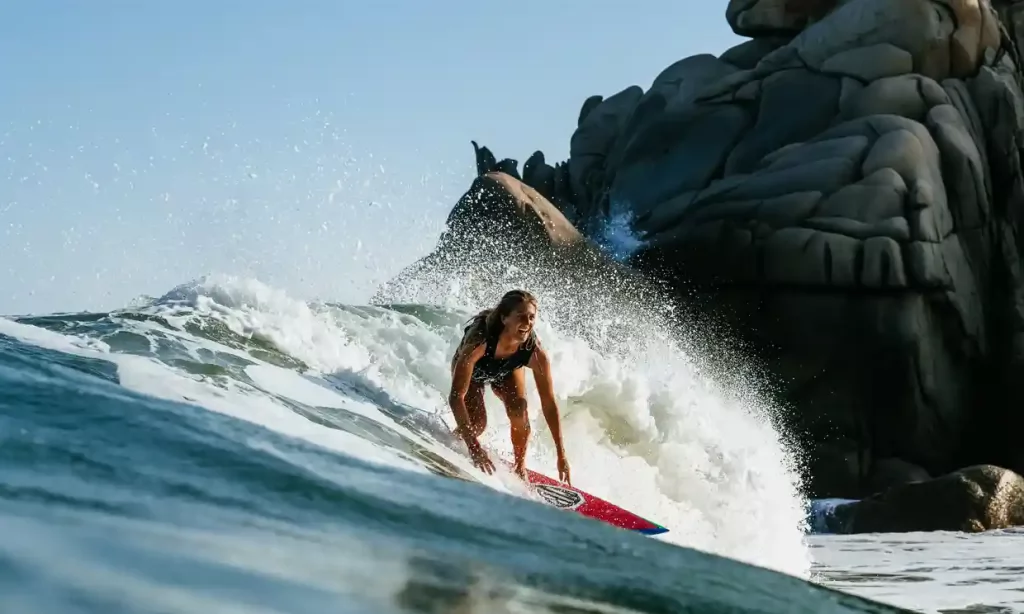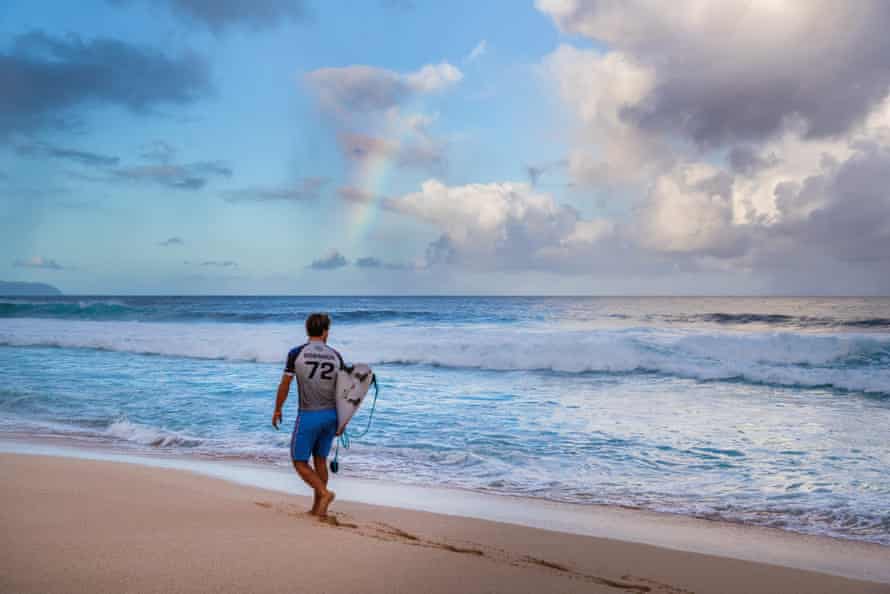Make or Break’s behind-the-scenes look at the World Surf League engages fans and non-fans alike even if some hard questions remain ignored

Seven-time world champion Stephanie Gilmore features in the new Apple TV+ series Make or Break. Photograph: Tony Heff/Apple TV
There is a moment early in the first episode of Make or Break, a new series from Apple TV+ about the World Surf League, when Tyler Wright neatly encapsulates the tension at the heart of professional surfing. “We come from a sport of, ‘aww we’re hippies’,” says the Australian surfer, a two-time WSL champion. “We’re not. We’re competitive little assholes.”
Surfing has long grappled with this bipolar identity; a sport initially beloved by the counter-culture movement that grew popular, some would say too popular, on the back of booming commercial and competitive success. Make or Break, an entertaining seven-part series, is the latest attempt by the surfing elite to capitalize on its popularity. Given the show has already been renewed for a second season – before it even went to air – they will most likely succeed.
It seems that no high-performance sport can flourish in the modern era without its own behind-the-scenes show on one or other of the rapidly-multiplying streaming platforms. Drive to Survive, the Netflix hit about Formula One, is perhaps the best example – now into its fourth season, the show has expanded the ranks of motorsport fans, including in the lucrative American market. Even before Drive to Survive, English football teams and US sporting franchises were experimenting with access-all-areas docu-series.
The success of these shows has sparked a content gold rush. In recent months, Drive to Survive equivalents have been announced for tennis, golf and the Tour de France. Surfing is already on the wave, with this new series developed by Drive to Survive producers James Gay-Rees and Paul Martin (the former is also known for his sporting classics Senna and Maradona).
Make or Break is captivating television. Professional surfing is a director’s dream – the WSL sends a small crew of male and female surfers around the world to compete at idyllic surfing locations. The editors have made liberal use of high-definition competition footage, as surfers charge heavy barrels and pull off gravity-defying aerial maneuvers against beautiful coastal backdrops. There is eye-candy galore.
But the show’s real triumph is its ability to engage surfing fans and non-fans alike with well-told stories. Make or Break gently explains and explores the complexity of professional surfing in a manner that makes it accessible for non-surfers, without alienating long-time WSL watchers. The show is unafraid to explore the gritty reality of life on tour, with heartfelt and revealing interviews.
“I’m tired to be on the road – I just want to be home,” admits an emotional Filipe Toledo. Another episode charts the challenges faced by the rookies, who live a precarious existence seeking to consolidate their WSL ranking and bank balance. “It’s only once you get results on the tour that you start earning the bucks,” says one. (Professional surfing is a top-heavy sport – the big stars sign million-dollar endorsement deals, while a few bad results can spell competitive and financial doom for others). Now-retired Australian surfing icon Mick Fanning, presented as some kind of wise owl of the surfing world, adds moments of levity throughout the series.
Drive to Survive has been criticised for glossing over Formula One’s shortcomings – its history of sportswashing, gender inequality and significant climate impact. Given Make or Break was produced in partnership with the WSL, it is surprising that the first season engages more fully with some of surfing’s own pitfalls. The first episode is particularly gripping, as the WSL confronts a longstanding inequality that has historically seen the women compete at Maui, while the men surfed at the more consequential and iconic Pipeline, on the Hawaiian leg of the tour.
“Surfing is sexist,” says a no-nonsense Wright. But a shark attack at Maui during last season’s event saw the women forced to finish the event at Pipeline, a famously-heavy wave. “It would be a moment in women’s surfing history … but at the same time, farrkkk it’s Pipe,” laughs Wright while weighing up the switch (she ultimately won the event). Pipeline now permanently hosts both the men’s and women’s competition, a positive development – albeit the sport’s lingering gender inequality remains evident in Make or Break, which focuses disproportionately on the men’s competition across the series.

Jack Robinson walks along the beach in one of Make or Break’s stunning surf locations. Photograph: Tony Heff/Apple TVAdvertisement
Make or Break may well elevate surfing to new heights. The sport’s inclusion in the Olympics last year was another step towards the mainstream; Wright’s brother, Owen, won bronze for Australia. By humanising the world’s best surfers (the frequent expletives suggest unfiltered footage), and accessibly explaining the sport’s vagaries, Make or Break will attract a wider audience to the WSL, just as Drive to Survive has done for Formula One. From the WSL’s perspective, the partnership will likely prove a shrewd commercial decision. In the new sporting era, content is king.
But it does leave a wider question unanswered – at what cost? What does commercial success and greater popular recognition, propelled by a new international TV series released by one of the world’s biggest technology companies, mean for the soul of surfing? Is the sport’s growing mass-appeal an unalloyed positive?
Midway through Make or Break, the WSL season heads to inland California, for an event at Kelly Slater’s Surf Ranch, a wave pool. This artificial competition setting is depicted as a pure test of surfing ability. “There’s nowhere to hide,” says one observer of the format, in which surfers compete individually on identical waves, ranked against the whole field, rather than in heat-by-heat contests subject to the whims of the ocean. Left unremarked is the profound philosophical shift prompted by wave pool surfing for a sport and past-time founded on a deep, even spiritual connection to the sea.
It may be too much to expect a glossy streaming series to explore such existential questions. The evolution of the sport, from its hippy roots to wave-pool competition broadcast around the globe, continues unabated. Make or Break will only give this trend greater momentum. But, at the very least, it is compelling viewing.
Make or Break premieres on 29 April on Apple TV+
 Arugam Forum
Arugam Forum Arugam Photo Galleries on Picasa
Arugam Photo Galleries on Picasa Old Website
Old Website Press Coverage
Press Coverage Surf Forecast for Arugam Bay
Surf Forecast for Arugam Bay
0 Responses to “Captivating new TV series searches for Drive to Survive impact on surfing”